
Back to Loco of the Month homepage
Back to Sidestreet Bannerworks
.
April 2010
Jack Wheldon's Buffalo Furnaces
by Marc Horovitz

Not much is known about the prototype of this engine. A Google search for Buffalo Furnaces Company (the lettering on the prototype-locomotive's side) yielded very little, except that perhaps it was an iron works in Buffalo, New York.
The standard-gauge locomotive was built by Brooks in 1895, according to the engine's builder's plate, as works No. 2526. Although it definitely has a lot of character, with its saddle tank and enormous cab, it was probably nothing more than a commonplace industrial locomotive used to haul materials around the iron works.
The story
For the very last Locomotive of the Month I wanted to choose something special, at least to me. This engine absolutely fills that requirement. It was built in 1985 by Jack Wheldon, an influential English builder and a good friend. I started corresponding with Jack in 1982. Jack was a prolific letter writer and we had an active and lively correspondence until his untimely death in 1988. Jack was also an artist and, among other things, designed the labels for Archangel's locomotive boxes. His letters, always hand written, were often adorned with illustrations in the margins. I had the great pleasure of meeting and staying with him on a couple of occasions. Running steam trains in his garden were some of the more memorable events in my life.
Two of Jack's locomotives have already been reviewed in these pages -- his Hecla and his Charles Pooter. Jack first mentioned Buffalo Furnaces to me in a letter dated April 5, 1984. The engine was commissioned by a man in Kansas and would represent the first (and, with its sister engine, only) American-style steam locomotive that Jack built. In his letter, Jack mentioned that he didn't feel he could spare the time to develop an internally fired boiler for this engine. Hence, it became a pot boiler. In fact, Jack decided to make two of this model -- one in gauge 1 for the Kansan and one in gauge 0 for himself.
The next mention of the engine didn't come until the 1st of March, 1986, almost a year later. Jack's letter reports of the successful air test of both chassis, with a promise of a photo.
In his next letter, dated the 10th of April, Jack duly sent a photograph of the pair of finished chassis. On the back of the picture he wrote: "'Buffalo Furnaces' switchers, in Gauge 1 & Gauge 0. The loco has been modified to run on narrow-gauge track: the frames are outside. The valve gear is full Walschaerts, divided so that the eccentric rod drives rearward."
.jpg)
In the letter accompanying the photograph of the chassis, Jack said that he steamed the 0-gauge version for the first time. He went on to discuss, at length, the boiler and firebox. The gauge-0 engine was built with a 1-1/2"-diameter boiler but, for the gauge-1 engine, he used a 2" tube to give the loco a longer duration.
On July 1, 1985, he wrote, "Both of the American switchers are complete: the Gauge 0 version carries the name plates 'Jocelyn' [after his wife] and BCR No. 5. The Gauge 1 at present is invisible, packed in foam padding inside a double cardboard box, wrapped in brown paper & parcel-taped all round. I'm waiting for C-- to give the OK for a trip to Kansas." He went on to say, "Both engines have proved to be exceedingly strong and well-behaved, now that they are halfway run in." This is followed by a lengthy description of the engines' running characteristics.
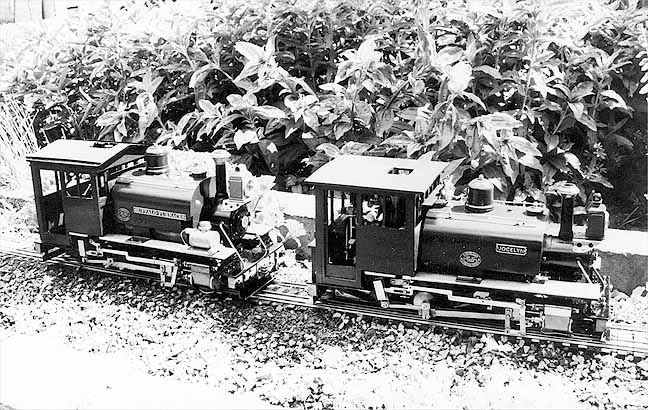
BELOW: Buffalo Furnaces, with its original wooden cab, awaiting shipment to America.
-- Both photos: D.B. Pinniger
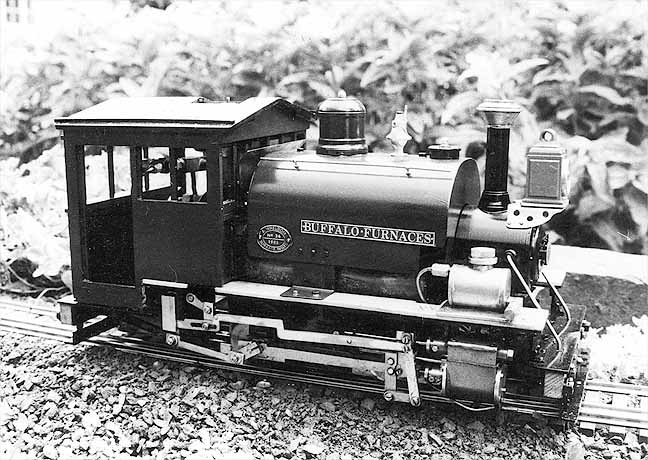
Again, in a letter dated the 16th of November, Jack asked if I had heard from C-- , as he had heard nothing from him for a long time.
I responded on November 27, writing, "Guess what!? I'm the proud new owner of Buffalo Furnaces!! Prompted by your last letter, I rang up C-- to see what was happening. After some lengthy discussion it became clear that he was, I think, discouraged, not only about the engine, but about life in general. I asked if he wanted to sell it and he reckoned he did."
.jpg)
From that day until this, that engine has been a cherished possession. However, for 25 years it never had a cab! I blush that it took me so long to build one for it. I honestly never liked the cab that Jack had built for the engine. When he passed away in 1988, Dave Pinniger sent me a sheaf of the papers associated with the engine from Jack's files. In it I found a prototype photograph and also a works drawing of the prototype. I decided to use those as the basis for the new cab.
Although the prototype had a wooden cab, I decided to make mine out of steel. Because of the way the engine is designed, some of the exhaust from the fire comes into the cab. I needed something durable. I also decided, as a sort of aesthetic experiment, to spot weld it together.
Based on the photo and the drawing, I drew up some plans. Since the prototype was standard gauge and the model narrow gauge, I had to take some liberties. I wanted to capture the essence of the prototype, though, so tried to incorporate all of the important characteristics of the large cab, including the unusual coal bunker at the back.
The roof comes off for access to the controls. There are two hatches in the roof. The forward one I left open, as it is just above the safety valve. The rear hatch is a dummy. The entire roof lifts off for access to the controls. The only modification to Jack's work that I made was to drill and tap four mounting holes in the floor for the new cab.
All in all, I was pleased with the result. It entirely changes the character of the locomotive, which I had been accustomed to seeing cabless for the past quarter century. It's a big engine! For more pictures of the cab under construction, click here.
The engine
Buffalo Furnaces is a large 0-4-0T. It has a pot boiler with porcupine quills, encased in a Wheldon firebox. A four-wick burner supplies the heat, with the fuel stored in a capacious tank beneath the cab. A large, round, Roscoe displacement lubricator adorns the right-hand running board.
The engine is fitted with proper Walschaerts valve gear, divided, as mentioned above, and controlled from the cab. The expansion link, which is straight, is actually under the cab. The long radius rod is notched to clear the eccentric crank as it's working. Cylinders are worked by D-valves. Two small tubes, connected to the exhaust line, come forward beneath the cylinders to represent drain cocks.
Unlike the prototype, the model has outside frames and solid drivers. It also has wooden running boards, backed up by steel -- a nice touch. Couplers are multi-position link-and-pins. The headlight is a commercial casting but the rest of the engine is entirely scratchbuilt.
The run
I had run this engine several times before but not for a long time. I carefully oiled it all round, filled the lubricator with steam oil, the boiler with distilled water, and the fuel tank with alcohol. The burner is tightly enclosed in the firebox but there is a cutout on either side for lighting the fire. I soaked my igniter with meths, lit it, then lit the fire through the opening near the wicks.
Because of the engine's boiler type and firebox design, steam came up fairly quickly. It was a warmish day, which helped. When blow-off pressure (75 psi) was reached, I put the engine in gear and opened the throttle a little. Oily water poured from the two cylinder-drain tubes and the engine lurched a little. I closed the throttle and put it into reverse. Upon opening the throttle again, the same thing happened. Steam was escaping up the stack and the engine was very balky. In addition to the water condensing in the cold cylinders, I suspect that a valve might have been stuck.
I kept doing this with little success until, all of a sudden, it was off, running smoothly and powerfully, with the safety valve periodically going off. After that, the run was superb. Buffalo Furnaces will run very fast but can easily be throttled down to a nice, sedate speed. The cylinder-drain tubes expelled most of the steam oil, keeping the top of the engine pretty clean. I found that I could read the pressure gauge and get my fingers around the controls of the locomotive through the cab windows without having to remove the roof.
The run lasted a half hour or so, with one or two replenishments of fuel. There is no way to fill the boiler under pressure on this engine, so I decided to shut it down at that point. Once it got going, the run was flawless, a perfect finale for the "Locomotive of the Month."
To hear an interview with Jack Wheldon, recorded in 1985, click here.
Here's a movie of Buffalo Furnaces in action. If, for some reason you can't view it, click here.
|
|
|
| Builder | Jack Wheldon (UK) |
| Date built | 1985 |
| Gauge | 1 gauge (45mm) |
| Scale | 16mm |
| Boiler | Pot with porcupine quills |
| Fittings | Safety valve, throttle, blowdown, pressure gauge |
| Fuel | Alcohol |
| Blow-off pressure | 75 psi |
| Cylinders | Two, double-acting D-valve |
| Reversing gear | Divided Walschaerts |
| Lubricator | Displacement |
| Weight | 8 pounds, 14 ounces (with new cab) |
| Dimensions | Length over end beams, 12-3/4"; width, 5"; height, 6-5/8" |
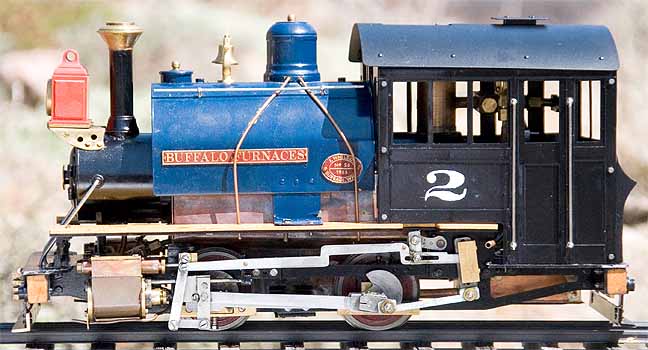
.jpg)
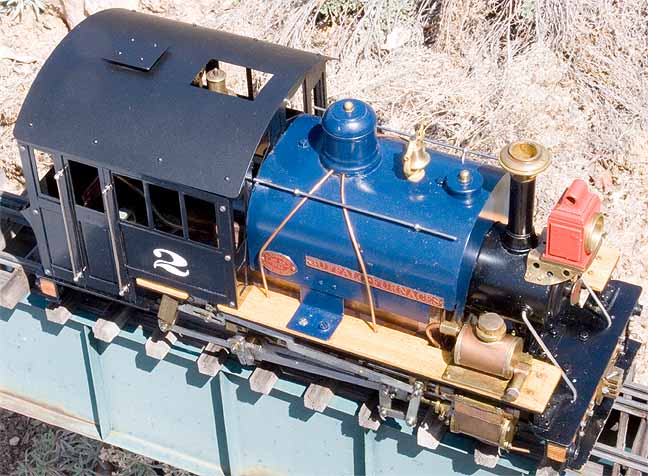

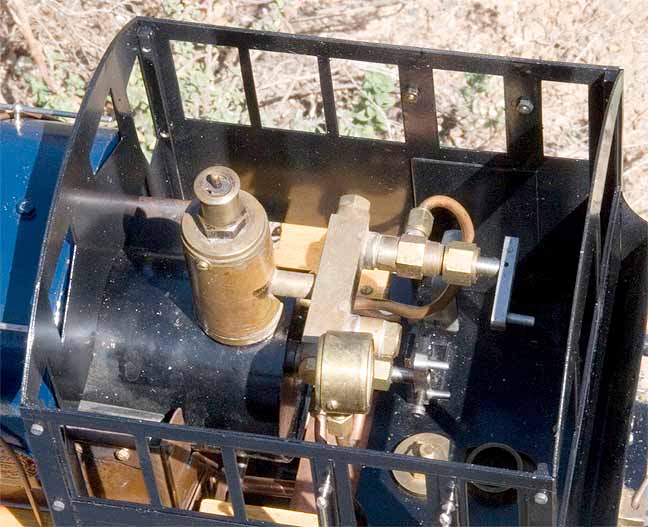

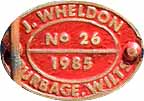
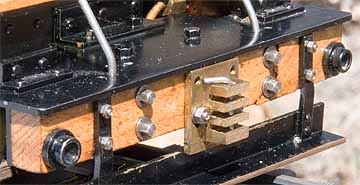

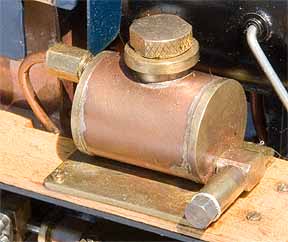
Below: Jack's doodle of Buffalo Furnaces, from the margin of one of his letters.


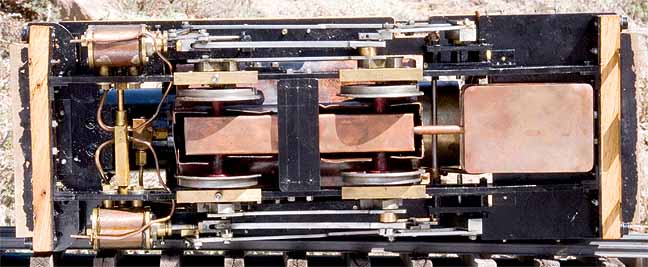
Back to Sidestreet Bannerworks home page
This page and its contents
Copyright Sidestreet Bannerworks, 2010
.